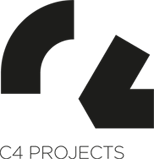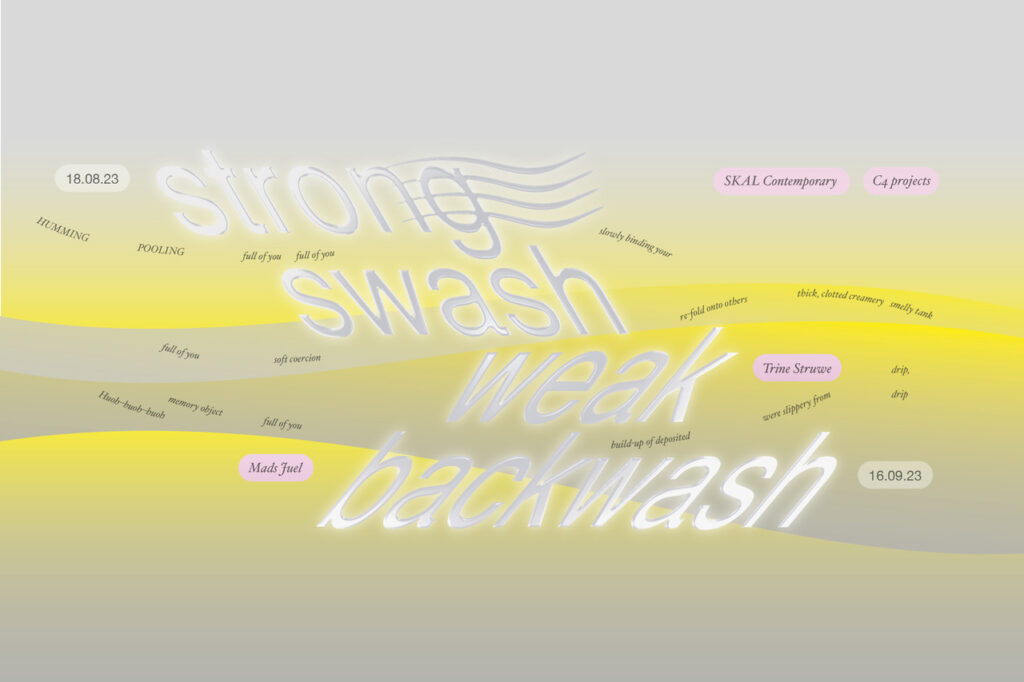STRONG SWASH,
WEAK BACKWASH
Duoudstilling af Trine Struwe og Mads Juel
Fernisering: Fredag 18. august 2023 kl. 17-20
Udstillingsperiode: 19. august – 16. september 2023
Havet bygger strande op af eroderet materiale transporteret andre steder fra. Strande er aflejringer, sedimenter, altså en slags bølgende skæringspunkter mellem det faste og flydende. Strong Swash, Weak Backwash er en duoudstilling af Trine Struwe og Mads Juel, kurateret af Anne Møller Christensen og Sara Løvschall Grøntved (SKAL Contemporary, Skagen). På baggrund af flere ophold i Skagen har Struwe og Juel arbejdet med havet som forbindelsesled for udvekslingen mellem steder. Vand forflyttes, både geografiske lokationer og kroppe imellem.
Afstand og udveksling er et gennemgående tema i Strong Swash, Weak Backwash. Mellem Skagen og Vesterbro, hav og land og i transit mellem steder og mennesker. Kontrasterne i Skagen er til at få øje på. Sommeren er pakket med turister på hver en flise og i hver en caféstol, om vinteren bliver det aldrig rigtigt lyst. Uden Skagensmalerne og kunstnerkolonien ville fortællingen om den nordligste by formentligt være markant anderledes. Byen er formet i udvekslingen mellem de lokale og dem, som kom andre steder fra. Med Strong Swash, Weak Backwash forflyttes en historietung, karakteristisk gul farve til det gulv, vi står på. To forskellige landskaber forbindes gennem fotografier, tekst og skulptur.
Fotografiets anatomi bliver udfoldet gennem eksperimenter med fremkaldelser og faktiske forflyttelser af materialer. Juels fotografier af beholdere fra hans barndomshjem taler om den slags hukommelse, der knytter sig til ting, som et forsøg på at forbinde sig over både tid og afstand. Fotografierne er foldet til postkortstørrelse og fysisk transporteret med fragtfirma fra Vesterbro til Skagen og tilbage igen for på den måde at opsamle materiale andre steder fra og lade det aflejre sig i fotografiernes endelige form. Med udgangspunkt i personlige oplevelser fokuserer Juels tekster på individets sårbarhed i relation og distance til det kollektive. Kroppen er en ustabil beholder, der opløses og samles igen gennem spejlinger af de landskaber, der omgiver os.
I en serie skulpturer støbt i arvet sølv synliggøres hulrummet i en særlig type af instrumenter. En hundefløjte er en lydløs fløjte, der anvender ultralyd. Det er frekvenser, som mennesker ikke kan høre, men som hunde kan. Frekvenser kan forbinde dyr og mennesker over store afstande. Hundefløjterne er støbt i genanvendt sølv arvet fra Struwes mor, søster og mormor, som dermed skaber en type af forbindelser til andre kroppe og de historier, der knytter sig til objekter, der går i arv.
Havet forbinder sig til vores kroppe og fletter to lokationer sammen. Brændingen får lov til at tale i Struwe og Juels serie af kunstnerbøger, der er skabt netop i skæringspunktet mellem vand og land. Sammen har de arbejdet med penneblæk og papir, der hvor bølgerne bryder. Den ene bog er produceret i Skagen og den anden i København.
Udstillingen er venligst støttet af Statens Kunstfond, 15. Juni Fonden, Københavns Kommune, Augustinus Fonden og William Demant Fonden.
*ENGLISH*
The sea builds up beaches from eroded materials transferred from elsewhere. Beaches are deposits, sediments, i.e. a kind of wavy intersection between the solid and the liquid. Strong Swash, Weak Backwash is a duo exhibition by Trine Struwe and Mads Juel curated by Anne Møller Christensen and Sara Løvschall Grøntved (SKAL Contemporary, Skagen). Based on several stays in Skagen, Struwe and Juel have worked with the sea as a link in the exchange between places. Water is moved between geographical locations and bodies.
Distance and exchange is a recurring theme in Strong Swash, Weak Backwash. Between Skagen and Vesterbro, sea and land, and in transit between places and people. The contrasts in Skagen are present and defining. Summer is packed with tourists everywhere, in winter it seems like the sun never rises. Without the painters and the artist colony in Skagen, the story of the northernmost town in Denmark would probably be remarkably different. The town is shaped by the exchange between the locals and those who came from elsewhere. With Strong Swash, Weak Backwash a historic, characteristic yellow color is transferred from Skagen to the floor in the exhibition space in Copenhagen. Two different landscapes are connected through photographs, text, and sculpture.
The anatomy of photography is unfolded through experiments with developments and actual movements of materials. Juel’s photographs of containers from his childhood home speak to the kind of memory that attaches to things, as an attempt to connect to them over both time and distance. The photographs are folded to postcard size and physically transported by a freight company from Vesterbro to Skagen and back again in order to collect material from other places and allow it to be part of the final form of the photographs. Based on personal experiences, Juel’s texts focus on the individual’s vulnerability in relation to and distance from a community of others. The body is an unstable container that dissolves and reassembles through reflections of the landscapes that surround us.
In a series of sculptures cast in inherited silver, the cavity of a special type of instrument is made visible. A dog whistle is a silent whistle that uses ultrasound. These are frequencies that humans cannot hear, but dogs can. Frequencies can connect animals and people over great distances. The dog whistles are cast in recycled silver inherited from Struwe’s mother, sister, and grandmother, which thus creates a connection to other bodies and the stories attached to objects that are passed down.
The sea is connected to our bodies, and in Strong Swash, Weak Backwash it weaves two locations together. The surf is allowed to speak in Struwe and Juel’s series of artist books that were made precisely at the intersection between sea and land. Together they have worked with pen ink and paper where the waves break. One book was produced in Skagen and the other in Copenhagen.
Strong Swash, Weak Backwash is kindly supported by the Danish Arts Foundation, 15. Juni Fonden, the Municipality of Copenhagen, Augustinus Fonden, and William Demant Fonden.

